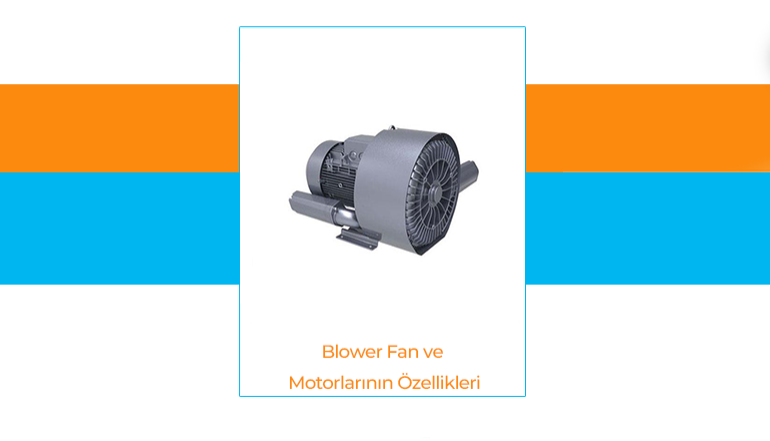- sisdoz@sisdoz.com.tr
- TR
Blog
- Home
- Sisdoz Blog
- All Features of Blower Fans and Motors

Silent Engineers of Power: All Features of Blower Fans and Motors
Blower fans and motors are at the heart of many industrial and commercial systems. These engineering marvels that operate silently but powerfully control air flow, change the air of environments and contribute to the efficient operation of systems. So, what makes blower fans and motors so special? Let's examine them in full detail.
1. What is a Blower Fan? Brief and Concise Definition
Blower fans are mechanical systems that direct air or gas and push it with high pressure. They are usually designed in centrifugal or axial structures. They serve in cooling, ventilation or process support by moving the air flow in the desired direction. They are encountered in a wide range from domestic use to heavy industry.
2. Perfect Harmony Between Motors and Fans
Motors at the heart of blower systems enable air flow by providing the rotational movement of the fan. The harmony between these two components determines the efficiency of the system. If the right motor type is not selected, the blower fan cannot show the desired performance. Therefore, technical parameters such as power, speed, torque are of great importance in motor selection.
3. High Efficiency: The Role of Blower Fans in Energy Saving
Energy saving is of great importance today both environmentally and economically. Blower fans provide maximum air flow with minimum energy when matched with the right motor. Blower fans, especially those used with inverter-controlled motors, prevent unnecessary energy consumption by adjusting their speed according to system needs. This offers serious cost advantages for businesses in the long term.
4. Different Blower Fan Types: Special Solutions for Every Need
Blower fans are produced in different types according to the application area. Some of these are:
Centrifugal Blowers: These are models where air is sucked into the center of the fan and discharged in a peripheral direction. They are generally preferred in systems requiring high pressure.
Axial Blowers: Air moves along the fan axis. They are used in large volume and low pressure applications.
Positive Displacement Blowers: These are models where air is compressed and directed. Ideal for process systems.
Each fan type works with different motor powers, providing application flexibility.
5. Basic Features to Look for in Blower Motors
There are some technical features to consider when choosing a blower motor:
High torque capacity: Important for the power needed for the first start of the fan.
Low vibration: Important for silent operation.
Long-lasting bearing structure: Provides suitability for continuous operation.
Thermal protection: Provides security against overheating.
Energy efficiency: Plays a key role for sustainable use.
Motors with these features help blower systems to have a long life and operate smoothly.
6. Areas of Use of Blower Fans: Where Do We Come Across Them?
Blower fans are not only found in factories or production facilities, but also in many areas of life. Here are some of the areas where they are most frequently used:
HVAC systems (heating, ventilation and air conditioning)
Purification plants
Food industry
Electronic cooling systems
Automotive sector
Dust collection systems
Pneumatic conveying lines
Such a wide area of use clearly reveals how critically important blower fans and motors are.
7. Low Noise, High Performance: The Importance of Acoustic Design
Noise pollution is a serious problem in industrial systems. However, modern blower fans and motors can operate at low noise levels thanks to their acoustically optimized designs. They offer maximum performance with minimum noise, especially thanks to their balanced impellers and insulated body structures. This both increases employee comfort and ensures compliance with legal regulations.
8. Ease of Maintenance and Longevity: Advantages of the Right Choice
Blower fans and motors can operate for many years with the right maintenance practices. For this:
Routine lubrication and cleaning
Regular control of filters
Monitoring of bearing temperatures
Noise and vibration tests
Measuring motor winding resistance
applications such as should be carried out. Blower systems equipped with quality components keep maintenance costs to a minimum.
9. 5 Golden Rules to Consider When Choosing a Blower
Finally, the following 5 critical points should definitely be considered when choosing a blower fan and motor system:
1. Application area Industrial or commercial?
2. Required air flow and pressure Technical values must be clearly determined.
3. Energy efficiency expectation High efficiency class should be preferred.
4. Working environment conditions Dusty, humid or chemical areas should be taken into consideration.
5. Noise level Silent operation is important especially in indoor use.
The right choice to be made in line with these criteria ensures that a system that is both efficient and economical is established.
10. Conclusion: You Are in Control with Blower Fans and Motors
Blower fans and motors are making a silent revolution in many areas from energy control to ambient air conditioning. Thanks to a correctly selected and well-integrated system, both energy savings are achieved and the life of the systems is extended. With the development of technology, blower systems are also becoming smarter, quieter and more efficient. If you want to take part in this transformation, you should know the features of blower fans and motors well and make choices that suit your needs.

